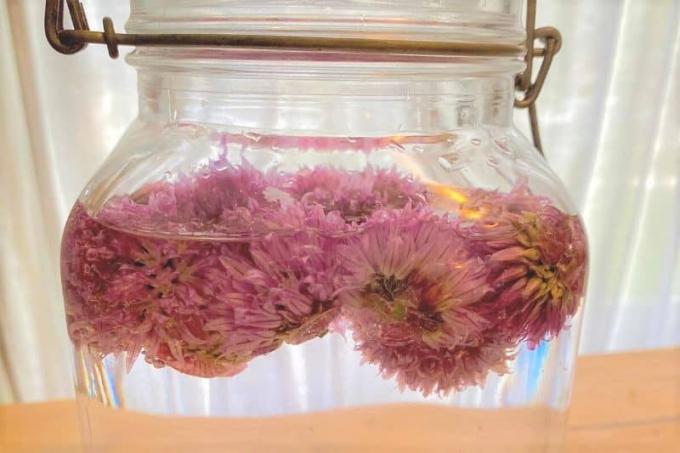
Chives are healthy and belong in every herb garden. The pink-purple flowers that form from May provide valuable food for bees and other beneficial insects. Are chive flowers edible?
In a nutshell
- Buds form from May, later pink-purple chive flowers
- valuable food for bees and insects
- Blossoming requires a lot of energy
- less aroma after flowering
- Chive flowers are edible
Table of contents
- chive blossoms
- Edible flowers
- Harvest chive flowers
- frequently asked Questions
chive blossoms
The first buds on the chives (Allium schoenoprasum) will be visible by May at the latest. They quickly get bigger, plump and burst open after a while. Only then do the purple flower pustules, which are typical of the onion plant and consist of a large number of small flowers, form.

The plant has to put a lot of energy into flowering, which means that the chive aroma is somewhat weaker during this time. A few weeks later the flowers dry up. They keep getting brighter.
A notice: Chives taste the most aromatic when you harvest them before they bloom.
Edible flowers
There is a rumor that chive flowers are poisonous. That's not true. The purple flowers of the chive are edible. However, they taste a little milder than the stalks. They are slightly sweet due to the nectar they contain. It is best to harvest chive blossoms in the early morning hours.
You can use the pretty flowers perfectly in the kitchen, for example
- for decorating cold plates
- as a topping on vegetable soups
- in salads
- for the preparation of chive butter

Tip: If you want to have some of the aromatic flowers for longer, you can pickle them in oil or vinegar.
Harvest chive flowers
The early morning hours are ideal for harvesting the edible flowers on the chives. The concentration of essential oils is highest in the morning. In addition, there are not that many insects around at this time. Here's how to do it correctly:
- Cut off the flowers with the stem using sharp scissors.
- Check the flowers. Only select clean, undamaged flowers for further processing.
- Sort out the flower stalks. These are firmer than the leaves, have a bitter taste and are not suitable for consumption. They can be disposed of in the compost.

A notice: Chive blossoms magically attract insects. We recommend shaking out the flowers thoroughly before using them in the kitchen and rinsing them off gently under running water if necessary.
frequently asked Questions
If you observe the leeks closely and remove the buds before they bloom, the plant can put all its energy into the leaves. In this way, the herbs remain aromatic and beautifully tender. We recommend removing part of the buds and leaving a few buds. So you have both delicate leeks and versatile flowers.
No, but the flowering period of chives is very long. Depending on the location and variety, it begins at the end of March and lasts into October.
Chives are perennial and hardy. Cut your chives close to the ground in the fall. You can freeze the leaves in the freezer for the winter. Chives are very robust and will sprout again next year. Winter protection is advisable in cold regions.
Chive buds can be pickled in vinegar and seasoned with mustard and peppercorns, bay leaf and salt and used as a substitute for capers. The buds are not suitable for raw consumption.
The leaves and flowers of the herb contain, among other things, vitamins A, B, C and E as well as essential minerals such as sodium and magnesium. It is also very "light", so 100 grams of chives have only 26.5 kilocalories.



